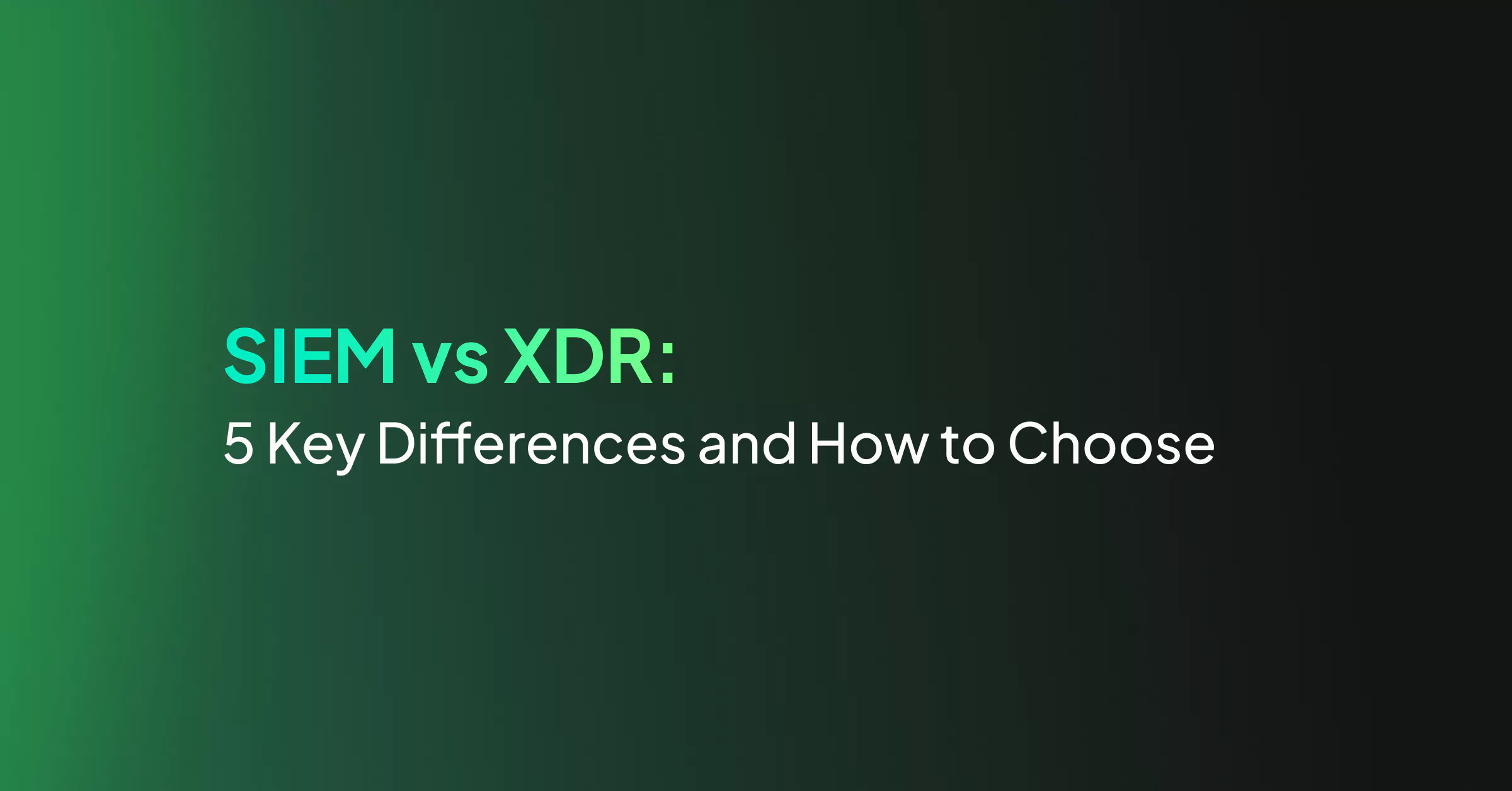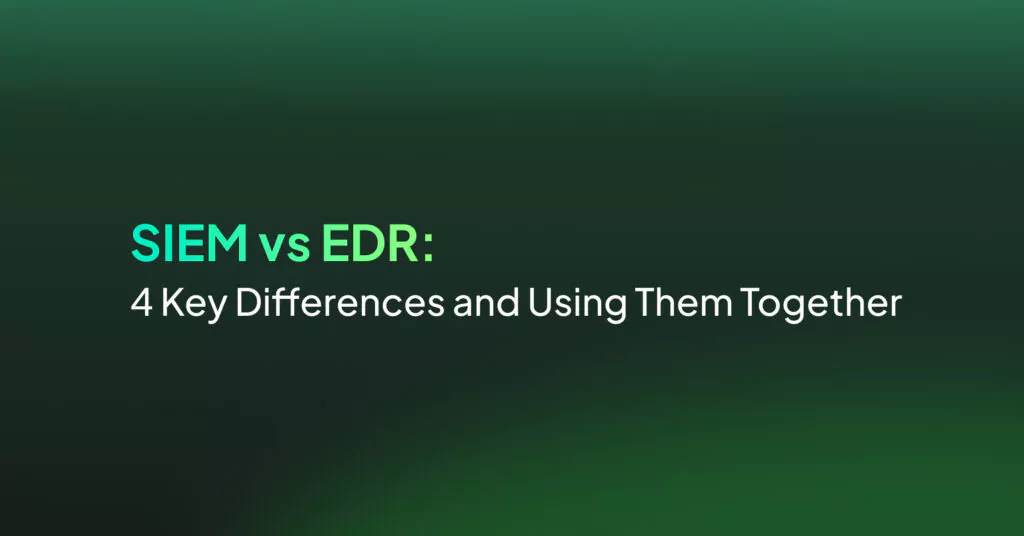SIEM vs XDR: 5 Key Differences and How to Choose

Key Capabilities of SIEM
SIEM systems offer a range of features to help organizations monitor, detect, and respond to security threats. These capabilities provide centralized visibility, improve compliance, and improve security operations:
- Log management and aggregation: SIEM systems collect log data from various sources, including firewalls, servers, endpoints, and applications. This centralized log management enables efficient storage, retrieval, and analysis of security-relevant data.
- Real-time event correlation: SIEM solutions use correlation engines to analyze diverse log data in real time. By identifying patterns and relationships between events, SIEM helps uncover security incidents, anomalies, or breaches that may otherwise go unnoticed.
- Incident detection and response: By continuously monitoring for abnormal activities and known attack patterns, SIEM enables rapid identification of security incidents. Integration with automated response tools allows organizations to take immediate actions, such as isolating affected systems or blocking malicious traffic.
- Compliance reporting: SIEM systems generate detailed reports to support regulatory compliance with standards like GDPR, HIPAA, and PCI DSS. These reports simplify audits by providing clear visibility into security measures and incident handling.
- Threat intelligence integration: Modern SIEM platforms incorporate threat intelligence feeds, which provide insights into known attack vectors and adversary tactics. This enriches the detection process and helps proactively defend against emerging threats.
- Forensic analysis: The centralized repository of log data maintained by SIEM enables thorough post-incident analysis. Security teams can reconstruct attack timelines, identify vulnerabilities, and refine defense strategies based on insights from past events.
Related content: Read our guide to SIEM tools
Key Capabilities of XDR
XDR extends the capabilities of traditional security solutions by integrating data across multiple layers of the security stack. Its features provide a unified approach to detecting and responding to complex threats, enabling more efficient cybersecurity management:
- Unified data integration: XDR consolidates data from diverse security tools, such as endpoint detection, email security, and network monitoring. This unified approach eliminates data silos, ensuring all relevant information is available for threat analysis.
- Advanced threat correlation: By correlating telemetry across multiple security layers, XDR improves the detection of sophisticated threats that span different vectors. This cross-layer analysis improves accuracy and reduces false positives.
- Automated threat detection and response: XDR solutions leverage automation to detect, analyze, and respond to threats faster. Predefined playbooks and AI-driven decision-making accelerate incident response, minimizing manual intervention and reducing dwell time.
- Improved security visibility: XDR provides a centralized, comprehensive view of the security landscape, offering actionable insights. This visibility enables security teams to prioritize threats and focus on the most critical incidents.
- Simplified investigation workflows: With integrated tools for investigation and forensics, XDR simplifies the process of analyzing incidents. Security teams can trace attack paths, understand root causes, and assess the full scope of an attack more effectively.
- Proactive defense with AI and machine learning: XDR systems use machine learning to identify behavioral anomalies and predict potential threats. This proactive defense mechanism helps organizations stay ahead of attackers by recognizing emerging patterns.
SIEM vs XDR: Key Differences
1. Core Focus
SIEM is primarily used to aggregate and analyze large volumes of log and event data from across an organization’s IT environment. Its strength lies in identifying patterns and correlations through rule-based mechanisms and providing insights for compliance, audit trails, and post-incident forensics. This is useful for organizations with strict regulatory requirements.
XDR is built for threat detection and response. Its focus extends beyond log aggregation to include real-time monitoring, cross-layer correlation, and automated incident response. Unlike SIEM, which often requires manual effort to interpret findings and take action, XDR provides actionable outcomes and simplifies response efforts.
2. Data Sources
SIEM systems gather data from a variety of sources, including network devices, servers, endpoints, applications, and third-party tools. This broad scope ensures a holistic view of IT activities but can sometimes overwhelm teams with large volumes of unfiltered data and alerts. Effective use of SIEM often requires substantial tuning to reduce noise and focus on critical events.
XDR integrates data natively from a controlled ecosystem of tools, such as endpoint detection and response (EDR), network traffic monitoring, and email security. This integration allows for a richer, more contextualized analysis of threats, reducing the reliance on external tools. As a result, XDR is better equipped to detect sophisticated multi-vector attacks that SIEM might overlook.
3. Management Complexity
Managing a SIEM system can be resource-intensive. Teams need to set up, configure, and regularly update correlation rules, as well as monitor for false positives and adjust the system accordingly. Without careful maintenance, SIEM can become inefficient, generating excessive noise or failing to detect key threats. Skilled personnel are often required to operate SIEM effectively, which can pose challenges for smaller teams or organizations with limited resources.
XDR simplifies management through automation and vendor-provided integrations. By leveraging machine learning and predefined playbooks, XDR reduces the manual effort required for rule creation, data correlation, and response. Additionally, its intuitive interfaces and guided workflows make it accessible even to less experienced teams, minimizing operational complexity while maximizing efficiency.
4. Delivery Model
SIEM solutions have traditionally been deployed on-premises, requiring significant investments in hardware, software, and personnel to manage the infrastructure. While cloud-based SIEM offerings have emerged, many organizations still need to handle updates, scaling, and maintenance themselves. This model can be burdensome, particularly for smaller teams or those lacking dedicated security resources.
XDR is typically delivered as a cloud-native platform, designed for scalability and ease of use. With automatic updates, centralized management, and the ability to handle large volumes of data without additional infrastructure, XDR provides a more agile and cost-effective solution.
5. Customization
SIEM offers customization capabilities, allowing organizations to create tailored correlation rules, dashboards, and reports that align with their unique security requirements. While this flexibility is an advantage, it also introduces complexity. Security teams must possess the expertise to fine-tune the system, which can lead to longer deployment times and a steeper learning curve.
XDR focuses on simplicity and usability. It relies on pre-configured analytics, vendor-defined playbooks, and automated workflows to deliver actionable insights quickly. Although this approach limits the degree of customization, it ensures a faster time-to-value and reduces the risk of misconfigurations. This trade-off makes XDR suitable for organizations looking for a simplified threat detection solution without the need for extensive configuration efforts.
Related content: Read our guide to SIEM monitoring
SIEM vs XDR: How to Choose?
Choosing between SIEM and XDR depends on the organization’s security needs, resources, and operational goals. Both solutions have distinct strengths, and the right choice will often hinge on the following factors:
Security requirements and priorities
- Choose SIEM if your organization requires log management, audit trails, and regulatory compliance reporting. SIEM is suitable for environments with complex compliance obligations or those that demand deep visibility into historical security data.
- Choose XDR if your primary focus is rapid threat detection and response. Organizations seeking an integrated, proactive approach to managing modern threats across multiple layers of their environment will benefit from XDR’s correlation and automation capabilities.
Team size and expertise
- SIEM suits larger teams with the expertise and resources to manage complex rule configurations, analyze large volumes of data, and fine-tune alerts. It’s a better fit for organizations with dedicated security operations centers (SOCs) or extensive in-house IT security capabilities.
- XDR is more accessible for smaller teams or those with limited security expertise. Its automated processes, predefined playbooks, and simplified workflows reduce the need for highly skilled personnel, making it easier to implement and operate.
Infrastructure and deployment preferences
- On-premises-heavy environments or those with strict data residency requirements may lean toward SIEM, particularly if cloud-based options are not feasible.
- Cloud-first organizations or those seeking scalable, low-maintenance solutions may prefer XDR. Its cloud-native design minimizes infrastructure management while ensuring continuous updates and high availability.
Budget and cost considerations
- SIEM typically requires higher upfront investments in hardware, software, and ongoing maintenance. The cost can be justified for large enterprises needing customization and long-term storage of security data.
- XDR offers a more cost-effective solution for organizations seeking predictable pricing and lower operational overhead. Its focus on out-of-the-box functionality reduces implementation and maintenance costs.
Threat landscape and risk tolerance
- If your organization faces highly targeted or compliance-driven risks, SIEM’s analysis capabilities and long-term log retention provide an advantage in forensic investigations and regulatory audits.
- If you need to combat sophisticated multi-vector attacks, XDR’s cross-layer integration and real-time response capabilities offer superior protection. Its machine learning and AI-driven detection improve resilience against emerging threats.
Hybrid approaches
- In some cases, a hybrid approach may be the best solution. Organizations can deploy SIEM for compliance and historical analysis while integrating XDR for real-time threat detection and response. This combination leverages the strengths of both technologies, ensuring comprehensive coverage.
Coralogix Managed SIEM
Coralogix sets itself apart in observability with its modern architecture, enabling real-time insights into logs, metrics, and traces with built-in cost optimization. Coralogix’s straightforward pricing covers all its platform offerings including APM, RUM, SIEM, infrastructure monitoring and much more. With unparalleled support that features less than 1 minute response times and 1 hour resolution times, Coralogix is a leading choice for thousands of organizations across the globe.





